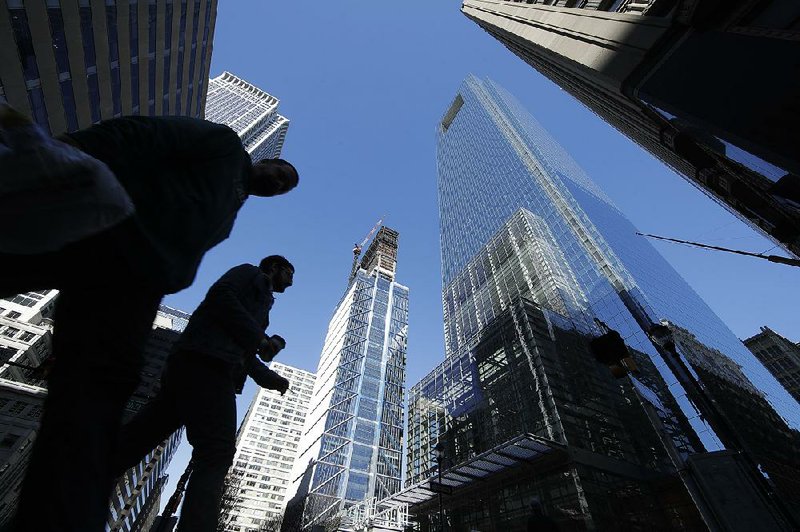WASHINGTON -- The U.S. economy turned in the weakest performance in three years in the January-March quarter as consumers sharply slowed their spending. The result fell far short of President Donald Trump's ambitious growth targets and underscores the challenges of accelerating economic expansion.
The gross domestic product, the total output of goods and services, grew by just 0.7 percent in the first quarter after a gain of 2.1 percent in the fourth quarter, the Commerce Department reported Friday.
The slowdown primarily reflected slower consumer spending, which grew at a seasonally adjusted annual rate of 0.3 percent after a growth rate of 3.5 percent in the fourth quarter. It was the poorest quarterly showing in more than seven years.
Despite the anemic first-quarter performance, the U.S. economy's prospects for the rest of the year appear solid. Growth is expected to be fueled by a revival in consumer spending, supported by continued strong job growth, accelerating wage gains and record stock levels.
Wage gains will play a bigger role in helping boost sentiment and offset the negative effects on consumer spending from higher inflation, said Tom Simons, an economist at Jefferies LLC in New York.
"The responses to the recent consumer confidence surveys have reflected that there's a pretty general level of comfort on that front," he said. "We have come a long way on inflation, but I don't see a lot of near-term continued upward pressure. I think the consumer is going to be in pretty decent shape" in the second quarter.
Weakness in the first quarter followed by a stronger expansion in the spring has become a pattern in recent years. The government's difficulty with seasonal adjustments for the first quarter has been a chronic problem and may have shaved as much as 1 percentage point off growth this year.
The sharp slowdown in consumer spending in the first quarter was attributed to a collection of temporary factors: warmer temperatures, which shrank spending on heating bills, a drop-off in auto sales after a strong fourth quarter and a delay in sending out tax-refund checks, which also dampened spending.
Sal Guatieri, senior economist at BMO Capital Markets, said he expected consumer and government spending to bounce back, leading to a much stronger second quarter.
"Still, the report will mark a rough start to the administration's high hopes of achieving 3 percent or better growth, not the kind of news it was looking for to cap its first 100 days in office," Guatieri said in a note to clients.
Averaging the first two quarters, economists forecast growth of around 2 percent for the first half of this year. That would be in line with the performance of the eight-year economic expansion, when growth has averaged just 2.1 percent, the poorest showing for any recovery in the post-World War II period.
Trump had repeatedly attacked the weak GDP growth rates during the campaign as an example of what he said were the Obama administration's failed economic policies. He said his program of tax cuts for individuals and businesses, deregulation and tougher enforcement of trade agreements would double growth to 4 percent or better.
In unveiling an outline of the administration's tax proposals on Wednesday, Treasury Secretary Steven Mnuchin said he believed growth above 3 percent would be achievable.
Economists are more skeptical. They are forecasting growth this year around 2.2 percent.
That broadening-out of demand across the U.S. economy should create a solid picture for the consumer in the second quarter, said Sam Bullard, senior economist at Wells Fargo Securities LLC in Charlotte, N.C.
"While we had weakness in the first two months of the quarter, things seem to be turning around," he said. "With a little more ammunition in savings and the housing market continuing to take off, the fundamentals for the consumer are still constructive towards growth."
GDP growth of 2.2 percent for 2017 would be an improvement from last year's 1.6 percent, the weakest showing in five years, but far below Trump's goal. Many analysts believe that the effects of Trump's economic program will not be felt until 2018 because they are not expecting Congress to approve some version of Trump's tax program until late this year.
The GDP report released Friday was the first of three estimates the government will make of first-quarter growth.
The 0.7 percent increase was the worst showing since GDP contracted by 1.2 percent in the first quarter of 2014.
In addition to weaker consumer activity, the first-quarter slowdown also reflected a cutback in restocking of store shelves. The slowdown in inventory rebuilding cut nearly a percentage point from growth in the first quarter. Also acting as a drag was a reduction in government spending, which fell at a 1.7 percent annual rate with both the federal government and state and local governments seeing cuts.
On the positive side, business investment rose at a 9.4 percent rate, helped by a record surge in spending in the category that tracks the energy sector. This category had seen sharp cutbacks in recent quarters, reflecting reductions in exploration and drilling as energy prices declined. Housing construction was also strong, growing at a 13.7 percent rate, the fastest pace in nearly two years.
"There's clear signs that wages and salaries are gaining some traction and we think that will continue with the labor market continues to tighten and slack diminishes," said Russell Price, senior economist at Ameriprise Financial Inc. in Detroit. "We believe strongly we will see a rebound in consumer activity."
Information for this article was contributed by Martin Crutsinger of The Associated Press and Michelle Jamrisko and Patricia Laya of Bloomberg News.
Business on 04/29/2017

